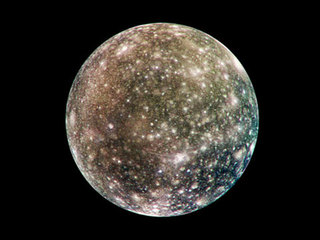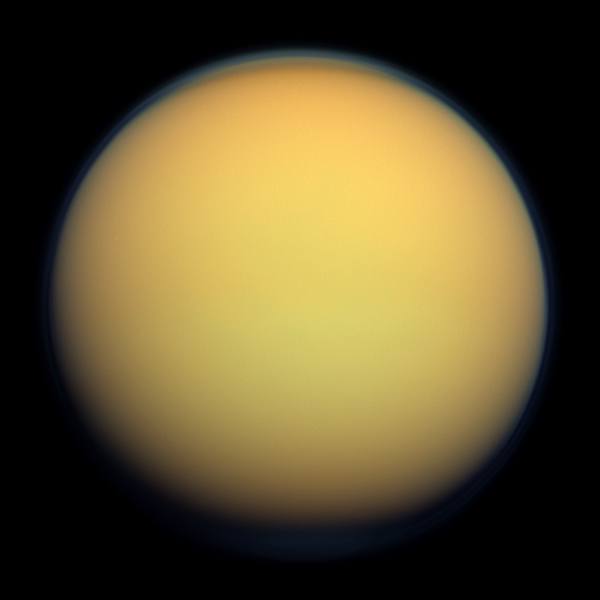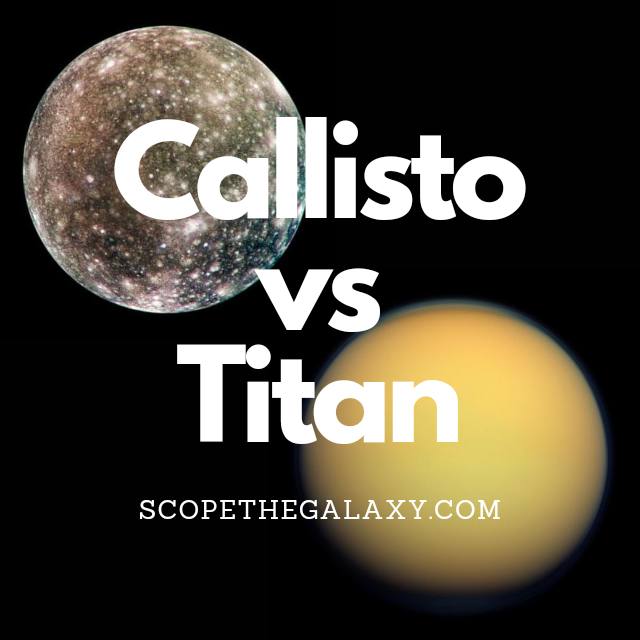*This post may contain affiliate links. This means we may make a commission if you purchase an item using one of our links*
The main differences between Callisto and Titan is that Titan is the 2nd largest moon in our solar system with a diameter of 5,150km whilst Callisto is 3rd with a diameter of 4,820.6km, Titan orbits Saturn whilst Callisto orbits Jupiter, Callisto has a very thin exosphere whilst Titan’s atmosphere is far thicker, roughly 1.19 times that of Earth and Titan has a water cycle similar to that of Earth whilst Callisto does not.
There numerous other differences between these two natural satellites so, continue reading for a more thorough breakdown of both celestial bodies along with their similarities and differences.
What Is The Moon Callisto?
Table of Contents

Callisto is one of the large moons orbiting Jupiter, the outermost of the Galilean moons, first discovered on 7th January 1610. The surface of this icy world is frozen, but scientists believe an underground ocean could reside beneath the ice.
Even if there’s water on Callisto, it won’t necessarily hold life because the surface is so old. Scientists will need to conduct more research into the moon before determining whether this is a likely possibility.
The ESA’s JUICE (Jupiter Icy Moon Explorer) mission is focused on the three ice moons of Jupiter. It is expected to arrive in 2030 and will focus on learning more about the environment of each, as well as their potential for hosting life.
Scientists estimate that Callisto is around 4.5 billion years old (the same age as Jupiter), and its average distance from the Sun is approximately 778 million km. It has a diameter of 4820.6km, which makes it similar in size to the planet Mercury, and the average temperature is a frigid minus 139.2 degrees Celsius.
Callisto takes seven days to orbit its planet at an average distance of 1,880,000km, and it is tidally locked, meaning the same side of it always faces Jupiter. But this moon experiences less tidal influence than the other Galilean moons because it lies in the orbit of Jupiter’s primary radiation belt.
The name of this moon is derived from the stories of Greek myth. Callisto was the nymph who had an affair with Zeus, the King of the Gods. Upon hearing this news, Zeus’ wife Hera turned Callisto into a star and placed her in the Ursa Major constellation. Interestingly, every moon of Jupiter is named after a Greek figure who Zeus seduced.
Callisto may be the third biggest moon and similar in size to the planet Mercury, but it only has a mass of 107,593,737,963.819 billion kg. That may sound like a lot, but it’s only ⅓ the mass of the similarly sized Mercury.
You may wonder why scientists classify Callisto as a “moon” rather than a planet if it’s almost the same size as Mercury. The reason is simple; planets must orbit the sun, but Callisto orbits one of the planets.
The composition of this frigid world is around 60% rock and iron and 40% ice. The moon has roughly equal amounts of rock and ice, plus the potential for water below the surface. There are also traces of carbon dioxide, organic compounds, and silicates.
This moon is one of the oldest landscapes in the Milky way and the most heavily cratered body in our system. However, scientists believe this could now be a “dead” moon as there are no longer any signs of volcanism or plate tectonics on its surface.
What Is The Moon Titan?

Titan is Saturn’s largest moon and the second biggest moon in the entire solar system, with a diameter of 5,150km. This would make it even larger than the planet Mercury which is only 4,879km, and significantly larger than Pluto also.
As a result, Titan’s gravitaional strength stands at around 1.352 m/s²
It is the only natural satellite in our solar system that is composed similarly to Earth, where it has a thick atmosphere (1.19 times that of Earth) made primarily of nitrogen (95%) along with smaller amounts of methane (5%).
It has rivers and lakes on its surface along with a water cycle very similar to that of Earth, where essentially water evaporates and eventually lands on the satellites surface.
Therefore, much like Earth, Titan has a terrestrial based body but, there is a difference in their atmospheric pressure. The pressure on Titan’s surface is around 60% greater than that of Earth’s surface but, it isnt nearly as dense.
Nevertheless, it is still far denser than most other bodies at 1.88 g/cm³. As a result, Titan’s mass is 1.345×10^23 kg.
In regards to its temperature, Titan is on the colder side where it averages around -179 degrees Celsius whilst its core’s temperature is actualluy very cold in comparison to other entities falling between 226 – 526 degrees Celsius.
As Saturn is the 6th farthest planet from the Sun, it will take Titan roughly the same amount of time to orbit the Sun, which would fall around 29.4 years.
It takes Titan 15 days and 22 hours to orbit Saturn. A day is 15 days and 22 hours also as it is tidally locked to the gas giant.
Similarities Between Callisto And Titan
As both are natural satellites, Callisto and Titan do share a few similarities, which includes the following:
- Both have a hotter central core.
- Both have a rocky, terrestrial surface.
- Both are spherical in shape.
- Neither have rings surrounding them.
- Both are tidally locked to their planet.
- Both orbit their planet in an elliptical pattern.
- Neither have a magnetic field.
- Neither have tectonic plates.
Differences Between Callisto And Titan
In regards to the differences between the two, they include the below:
- Titan is the bigger of the two with a diameter of 5,150km whilst Callisto has a diameter of 4,820.6km.
- Callisto orbits Jupiter whilst Titan orbits Saturn.
- Callisto has a very thin exosphere composed of carbon dioxide whilst Titan’s atmosphere is 1.19 times as thick as Earth’s and is composed of nitrogen and smaller amounts of methane.
- Titan has a water cycle similar to that of Earth whilst Callisto does not have a water cycle.
- A day on Callisto is 17 days whilst a Titan day is 15 days and 22 hours.
- It takes Callisto 17 days to orbit Jupiter whilst Titan orbits Saturn in 15 days and 22 hours.
- Titan orbits Saturn at an average distance of 1.2 million km whilst Callisto is 1.88 million km from Jupiter.
- Titan’s axial tilt is 27 degrees whilst Callisto’s axial tilt is 0.
- Callisto’s entire body is covered with craters whilst Titan’s body wouldn’t be nearly as covered due to its atmosphere.
- Titan has a water cycle similar to that of Earth whilst Callisto does not have a water cycle.
- Callisto’s average temperature is around -139.2 degrees Celsius whilst Titan’s average temperature is -179 degrees Celsius.
- Titan’s density is 1.88 g/cm³ whilst Callisto’s density is 1.83 g/cm³.
- Titan’s mass is 1.345×10^23 kg whilst Callisto’s mass is 1.07×10^23 kg.
- Callisto’s gravitational strength is 1.236 m/s² whilst Titan’s is 1.352 m/s².
Summary
Although Callisto and Titan are both natural satellites, with a low density terrestrial body that both orbit the largest gas giants in our solar system, they have their fair share of differences too, with the most prominent being how different their appearance is from one another.
Whether it be in regards to their mass, size, atmosphere structure, length of their days and more, Callisto and Titan are clearly designed to be and ultimately function very disntinctly from one another.

